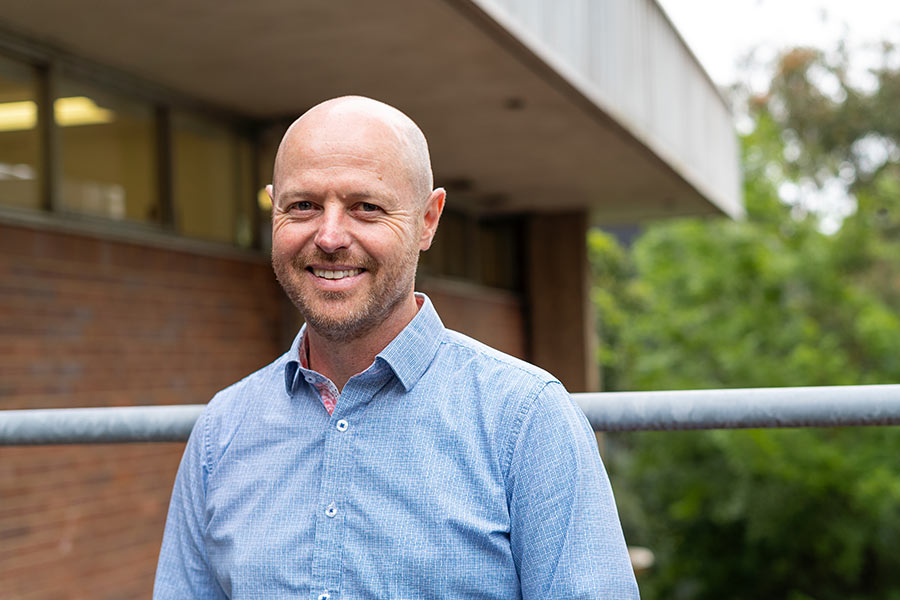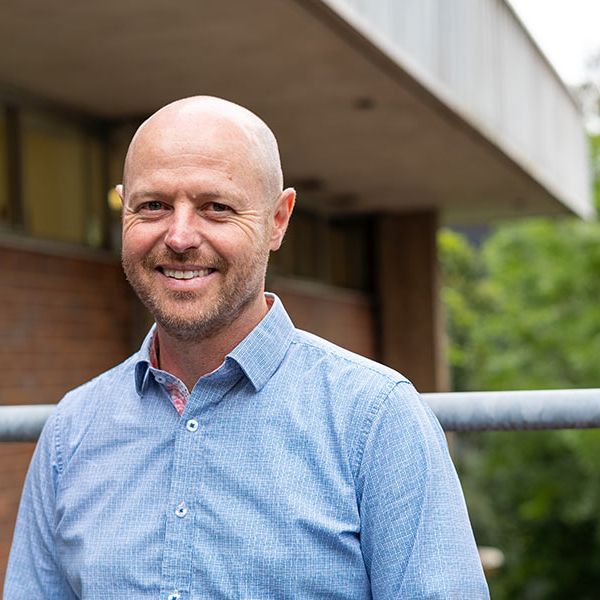Replicating cyanobacterial CO2 capture to boost crops and fight climate change
Dr Ben Long
Cyanobacteria are known for making toxins. But Dr Ben Long, head of the University’s Biological CO2 Capture Lab, member of the Biosafety Committee and Director of the Don McNair Herbarium, is using them to learn and do good.

“My work focuses on understanding and harnessing the mechanisms cyanobacteria—commonly known as blue-green algae—use to capture carbon dioxide,” Ben explains.
He adds that they employ a system called a ‘CO2 concentrating mechanism’ (CCM), which allows them to capture CO2 from the atmosphere efficiently. In contrast, land plants, including major crops, are slower and less efficient at this process.
Building on these insights, Ben’s team is working to transfer CCM components to plants. “Our research aims to enhance plants' ability to capture carbon from the air,” he says.
Mathematical modelling suggests promising results: “Plants equipped with a cyanobacterial CCM could collect up to 60 per cent more carbon,” Ben notes. “This provides a new way to boost crop production and mitigate climate change through CO2 reduction.”
Different CO2 capturing strategies
While Ben’s background is in plant biochemistry, his PhD research focused on how cyanobacteria produce the toxins they’re known for.
“I became intrigued by these microorganisms, whose evolution is closely linked to plants,” he says.
“Cyanobacteria and the green chloroplasts in plant cells share a common ancestor dating back hundreds of millions of years,” Ben explains. “But over time, each evolved different strategies for capturing CO2 from the atmosphere.”
The intricate steps each system developed to efficiently capture CO2 provide endless opportunities for researchers to uncover how they function.
“The cyanobacterial CCM is a complex system with multiple elements working in concert, and every discovery along the way has been a ‘eureka’ moment for me.”
Ship in a bottle challenge
Building a CCM inside a plant chloroplast is a bit like building a ship in a bottle, Ben explains—only harder because they don’t yet know all the components required.
However, unlike the ship analogy, the CCM system needs to functionally operate once it’s built.
“So far, we’ve made enormous steps towards this goal. But it’s a long, slow engineering process, says Ben. “Each step is an opportunity to learn and often results in a reconsideration of how the step was made and how it could have been done better.”
As a result, their work is highly iterative, with every advance providing a chance to reconsider the approach and explore better paths forward.
Cyanobacterial CCM: part 1
So, what does the cyanobacterial CCM look like? Ben explains that it consists of a two-part system.
The first part involves biochemical pumps located on the cyanobacterial cell membrane that actively transport bicarbonate into the cell. Bicarbonate is the primary form that CO2 takes when dissolved in water, highlighting a key difference between how plants and cyanobacteria capture CO2 in aquatic environments.
While CO2 can freely move across cell membranes, bicarbonate struggles to enter a cell due to its negative charge. This makes bicarbonate pumps essential components of the CCM.
However, researchers have faced significant challenges in getting plants to construct these pumps, position them correctly, and ensure they function effectively.
“It’s been a fun journey that has led us to use a ‘directed evolution’ approach, allowing us to harness nature to solve our challenges,” Ben adds.
Cyanobacterial CCM: part 2
The other part of the CCM is a very large protein complex called a carboxysome.
“It’s a structure that looks a little like a virus and has the same shape as a 20-sided icosahedral die like you’d find in a Dungeons & Dragons game”, continues Ben.
The carboxysome is a specialised compartment in a cyanobacterial cell that has a protein shell surrounding it and is packed with the world’s most abundant enzyme, Rubisco. Rubisco’s job is to turn CO2 into simple sugars, and it’s responsible for almost all the organic carbon molecules in living organisms on Earth.
Inside this massive carboxysome, bicarbonate is converted back into CO2 by another enzyme called carbonic anhydrase, flooding the Rubisco compartment with gas. This allows Rubisco to operate at its maximum efficiency, and cyanobacterial Rubiscos are among the fastest on the planet, making this system one of the quickest ways to transform gaseous CO2 into sugars.
“Building the carboxysome inside a plant cell chloroplast is an enormously complex challenge. In our ship-in-a-bottle analogy, it’s like cooking the captain’s dinner in the ship’s galley after the ship has already been built,” Ben says.
He adds, “Constructing both the transporters and the carboxysome inside plant chloroplasts are key goals for our work. Each presents significant challenges, but we’re learning so much along the way.”
A dogged attitude, a willingness to try innovative and risky approaches, and an understanding that there is almost always a way to achieve such goals have been the secret to their progress.
Demonstrating biotech applications
The research being done by Ben and his team has paved the way for new strategies for enhanced crop production and biological CO2 capture using biotechnology.
Their strategy coincides with a dramatic change in research focus around the world to use plant biotechnology to improve global food security.
They’re now seeing enormous steps forward in applying technologies such as theirs to improve food production in developing nations and for others to take on difficult bioengineering strategies to enhance plant performance.
Similar projects to theirs are now being applied to enhance carbon sequestration from the atmosphere to help mitigate climate change and they’re seeing an explosion in the field of applied translational outcomes to improve plant performance.
These approaches will have far-reaching effects as more outcomes are translated from the lab to the field.
At a local level, Ben shares that it has been overwhelming to see Australian scientists lead the way in biological technologies that can transform how plants perform.
“Our team provides that critical hub for learning how these technologies can be applied. I see our role as not only looking to improve the future through technological advances but to train the next generation that can make use of those achievements and push them forward.”
Advancing biotech together
Ben says they’ve been lucky to interact with philanthropic organisations around the world that have an interest in improving the lives of people in developing nations and making an impact on reducing climate change.
“These partners have been critical in publicising the importance of our work and how it can have an impact globally. We’ve also connected with dozens of collaborative partners in research institutions around Australia and across the world, generating a network of research interest to advance technologies like ours.”
Their work is currently listed as ‘awaiting funding’ through the Carbon Technology Research Foundation. It has previously been supported by the Bill & Melinda Gates Foundation, UK Aid and the Foundation for Food & Agriculture Research (FFAR) as part of the RIPE research consortium.
Ben is directly training the next generation and advancing his work by contributing to first and second-year biology/biotechnology teaching and third-year biotechnology student supervision.
Part of this involves supervising Hons and PhD research students working on projects related to biological CO2 capture, something he really enjoys.
“The thrill of empowering students to explore new ideas—regardless of whether they succeed or fail—encourages resilience and fosters a mindset of perseverance. This broadens their opportunities and increases their chances of success, making the experience both motivating and exciting.”
From economic to eco benefits
Ben admits that their work is still some way off achieving their original goals but says the potential benefits are enormous.
“Application of our technologies to crop plants has the potential to improve water use efficiency, nitrogen fertiliser use, and improve carbon capture. These are likely to have far-reaching benefits.”
To give it some perspective, he gives the example of the ability of a small-holder farmer in a developing country to increase their crop production with less water and less fertiliser means she has an improved income to send her children to school.
“This alone would generate profound social, economic, and environmental benefits,” Ben says, adding that it could also help reduce atmospheric CO2 and contribute to climate change mitigation.
Who knew that the key to a sustainable future could be found in the depths of something as unassuming as cyanobacteria?
The University of Newcastle acknowledges the traditional custodians of the lands within our footprint areas: Awabakal, Darkinjung, Biripai, Worimi, Wonnarua, and Eora Nations. We also pay respect to the wisdom of our Elders past and present.
